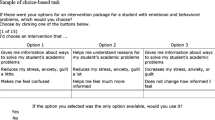Abstract
We used discrete choice conjoint analysis to model the bullying prevention program preferences of educators. Using themes from computerized decision support lab focus groups (n = 45 educators), we composed 20 three-level bullying prevention program design attributes. Each of 1,176 educators completed 25 choice tasks presenting experimentally varied combinations of the study’s attribute levels. Latent class analysis yielded three segments with different preferences. Decision Sensitive educators (31%) preferred that individual schools select bullying prevention programs. In contrast, Support Sensitive educators (51%) preferred that local school boards chose bullying prevention programs. This segment preferred more logistical and social support at every stage of the adoption, training, implementation, and long term maintenance processes. Cost Sensitive educators (16%) showed a stronger preference for programs minimizing costs, training, and implementation time demands. They felt prevention programs were less effective and that the time and space in the curriculum for bullying prevention was less adequate. They were less likely to believe that bullying prevention was their responsibility and more likely to agree that prevention was the responsibility of parents. All segments preferred programs supported by the anecdotal reports of colleagues from other schools rather than those based on scientific evidence. To ensure that the bullying prevention options available reflect the complex combination of attributes influencing real world adoption decisions, program developers need to accommodate the differing views of the Decision, Support, and Cost Sensitive segments while maximizing the support of parents and students.

Similar content being viewed by others
Notes
Sometimes referred to by market researchers as part-worth utility values (Orme 2006)
References
Allenby, G. M., Arora, N., & Gintner, J. L. (1995). Incorporating prior knowledge into the analysis of conjoint studies. JMR, Journal of Marketing Research, 32, 152–162. doi:10.2307/3152044.
Armitage, C. J., & Conner, M. (2001). Efficacy of the theory of planned behaviour: a meta-analytic review. The British Journal of Social Psychology, 40(4), 471–499. doi:10.1348/014466601164939.
Arseneault, L., Walsh, E., Trzesniewski, K., Newcombe, R., Caspi, A., & Moffitt, T. E. (2006). Bullying victimization uniquely contributes to adjustment problems in young children: a nationally representative cohort study. Pediatrics, 118(1), 130–138. doi:10.1542/peds.2005-2388.
Barbour, R. S. (1999). The case for combining qualitative and quantitative approaches in health services research. Journal of Health Services Research & Policy, 4(1), 39–43.
Caruso, E. M., Rahnev, D. A., & Banaji, M. R. (2009). Using conjoint analysis to detect discrimination: revealing covert preferences from overt choices. Social Cognition, 27(1), 128–137. doi:10.1521/soco.2009.27.1.128.
Coast, J. (1999). The appropriate uses of qualitative methods in health economics. Health Economics, 8(4), 345–353. doi:10.1002/(SICI)1099-1050(199906)8:4<345::AID-HEC432>3.0.CO;2-Q.
Craig, W. M., Pepler, D., & Atlas, R. (2000). Observations of bullying in the playground and in the classroom. School Psychology International, 21(1), 22–36. doi:10.1177/0143034300211002.
Cunningham, C. E., Deal, K., Rimas, H., Buchanan, D. H., Gold, M., Sdao-Jarvie, K., et al. (2008). Modeling the information preferences of parents of children with mental health problems: a discrete choice conjoint experiment. Journal of Abnormal Child Psychology, 7(36), 1128–1138.
Cunningham, C. E., Vaillancourt, T., Cunningham, L. J., & Short, K. (2009). The bullying prevention attitudes scale. Unpublished manuscript.
Cunningham, C. E., Cunningham, L. J., Martorelli, V., Tran, A., Young, J., & Zacharias, R. (1998). The effects of primary division, student-mediated conflict resolution programs on playground aggression. Journal of Child Psychology and Psychiatry, and Allied Disciplines, 39(5), 653–662. doi:10.1017/S0021963098002558.
Cunningham, C. E., Woodward, C. A., Shannon, H. S., MacIntosh, J., Lendrum, B., Rosenbloom, D., et al. (2002). Readiness for organizational change: a longitudinal study of workplace, psychological and behavioural correlates. Journal of Occupational and Organizational Psychology, 75(4), 377–392. doi:10.1348/096317902321119637.
DeSarbo, W. S., Ramaswamy, V., & Cohen, S. H. (1995). Market segmentation with choice-based conjoint analysis. Marketing Letters, 6(2), 137–147. doi:10.1007/BF00994929.
Elias, M. J., Zins, J. E., Graczyk, P. A., & Weissberg, R. P. (2003). Implementation, sustainability, and scaling up of social-emotional and academic innovations in public schools. School Psychology Review, 32(3), 303–320.
Fagan, A. A., & Mihalic, S. (2003). Strategies for enhancing the adoption of school-based prevention programs: lessons learned from the blueprints for violence prevention replications of the life skills training program. Journal of Community Psychology, 31(3), 235–253. doi:10.1002/jcop.10045.
Fekkes, M., Pijpers, F. I., & Verloove-Vanhorick, S. P. (2006). Effects of antibullying school program on bullying and health complaints. Archives of Pediatrics & Adolescent Medicine, 160(6), 638–644. doi:10.1001/archpedi.160.6.638.
Frey, K. S., Hirschstein, M. K., Snell, J. L., Edstrom, L. V., MacKenzie, E. P., & Broderick, C. J. (2005). Reducing playground bullying and supporting beliefs: an experimental trial of the steps to respect program. Developmental Psychology, 41(3), 479–490. doi:10.1037/0012-1649.41.3.479.
Gamage, J., & Weerahandi, S. (1998). Size performance of some tests in one-way anova. Communications in Statistics Simulation and Computation, 27(3), 625–640. doi:10.1080/03610919808813500.
Greenberg, M. T. (2004). Current and future challenges in school-based prevention: the researcher perspective. Prevention Science, 5(1), 5–13. doi:10.1023/B:PREV.0000013976.84939.55.
Greenberg, M. T., Weissberg, R. P., O’Brien, M. U., Zins, J. E., Fredericks, L., Resnik, H., et al. (2003). Enhancing school-based prevention and youth development through coordinated social, emotional, and academic learning. The American Psychologist, 58(6–7), 466–474. doi:10.1037/0003-066X.58.6-7.466.
Greenhalgh, T., Robert, G., Macfarlane, F., Bate, P., & Kyriakidou, O. (2004). Diffusion of innovations in service organizations: systematic review and recommendations. The Milbank Quarterly, 82(4), 581–629. doi:10.1111/j.0887-378X.2004.00325.x.
Gregory, A., Henry, D. B., & Schoeny, M. E. (2007). School climate and implementation of a preventive intervention. American Journal of Community Psychology, 40(3–4), 250–260. doi:10.1007/s10464-007-9142-z.
Gustafsson, A., Herrmann, A., & Huber, F. (2007). Conjoint analysis as an instrument of market research practice. In A. Gustafsson, A. Herrmann & F. Huber (Eds.), Conjoint measurement (pp. 3–34). Berlin, Germany: Springer.
Hensher, D. A., Rose, J. M., & Greene, W. H. (2005). Applied choice analysis A primer. New York-U.S.A.: Cambridge University Press.
Hoagwood, K., & Johnson, J. (2003). School psychology: a public health framework I. From evidence-based practices to evidence-based policies. Journal of School Psychology, 41(1), 3–21. doi:10.1016/S0022-4405(02)00141-3.
Huber, J., Orme, B., & Miller, R. (2007). Dealing with product similarity in conjoint simulations. In A. Gustafsson, A. Herrmann & F. Huber (Eds.), Conjoint measurement: methods and applications (4th ed., pp. 347–362). New York: Springer.
Kallestad, J. H. (2003). Predicting teachers’ and schools’ implementation of the olweus bullying prevention program: a multilevel study. Prevention & Treatment, 6, 3–21.
Kim, Y. S., Leventhal, B. L., Koh, Y. J., Hubbard, A., & Boyce, W. T. (2006). School bullying and youth violence: causes or consequences of psychopathologic behavior? Archives of General Psychiatry, 63(9), 1035–1041. doi:10.1001/archpsyc.63.9.1035.
Lenk, P. J., DeSarbo, W. S., Green, P. E., & Young, M. R. (1996). Hierarchical bayes conjoint analysis: recovery of partworth heterogeneity from reduced experimental designs. Marketing Science, 15(2), 173–192. doi:10.1287/mksc.15.2.173.
Lochman, J. E. (2003). Commentary: school contextual influences on the dissemination of interventions. School Psychology Review, 32(2), 174–178.
Louviere, J., Hensher, D., & Swait, J. (2007). Conjoint preference elicitation methods in the broader context of random utility theory preference elicitation methods. In A. Gustafsson, A. Herrmann & F. Huber (Eds.), Conjoint measurement-methods and applications (4th ed., pp. 167–197). New York: Springer.
Luce, R. D., & Tukey, J. W. (1964). Simultaneous conjoint measurement: a new type of fundamental measurement. Journal of Mathematical Psychology, 1(1), 1–27. doi:10.1016/0022-2496(64)90015-X.
Merrell, K. W., & Isava, D. M. (2008). How effective are school bullying intervention programs? School Psychology Quarterly, 23(1), 26–42. doi:10.1037/1045-3830.23.1.26.
Midthassel, U. V. (2008). Is the sustainability of reduction in bullying related to follow-up procedures? Educational Psychology, 28(1), 1–13. doi:10.1080/01443410701449278.
Mytton, J., DiGuiseppi, C., Gough, D., Taylor, R., & Logan, S. (2006). School-based secondary prevention programmes for preventing violence. Cochrane Database of Systematic Reviews (Online), 3. doi:10.1002/14651858.CD004606.pub2.
Olweus, D. (1994). Bullying at school: basic facts and effects of a school based intervention program. Journal of Child Psychology and Psychiatry, and Allied Disciplines, 35(7), 1171–1190. doi:10.1111/j.1469-7610.1994.tb01229.x.
Orme, B. K. (2006). Getting started with conjoint analysis: strategies for product design and pricing research. Madison: Research Publishers.
Patterson, M., & Chrzan, K. (2004). Partial profile discrete choice: what’s the optimal number of attributes? (pp. 173–185). San Antonio, TX: 2003 Sawtooth Software Conference Proceedings.
Payne, A. A., Gottfredson, D. C., & Gottfredson, G. D. (2006). School predictors of the intensity of implementation of school-based prevention programs: results from a national study. Prevention Science, 7(2), 225–237. doi:10.1007/s11121-006-0029-2.
Perkins, M. B., Jensen, P. S., Jaccard, J., Gollwitzer, P., Oettingen, G., Pappadopulos, E., et al. (2007). Applying theory-driven approaches to understanding and modifying clinicians’ behavior: what do we know? Psychiatric Services (Washington, D.C.), 58(3), 342–348. doi:10.1176/appi.ps.58.3.342.
Phillips, K. A., Johnson, F. R., & Maddala, T. (2002). Measuring what people value: a comparison of “attitude” and “preference” surveys. Health Services Research, 37(6), 1659–1679. doi:10.1111/1475-6773.01116.
Ramaswamy, V., & Cohen, S. H. (2007). Latent class models for conjoint analysis. In A. Gustafsson, A. Herrmanm & F. Huber (Eds.), Conjoint measurement methods and applications (4th ed., pp. 295–320). Heidelberg: Springer.
Ringeisen, H., Henderson, K., & Hoagwood, K. (2003). Context matters: schools and the “research to practice gap” in children’s mental health. School Psychology Review, 32(2), 153–169.
Rogers, E. M. (2003). Diffusion of innovations (5th ed.). New York: Free.
Rones, M., & Hoagwood, K. (2000). School-based mental health services: a research review. Clinical Child and Family Psychology Review, 3(4), 223–241. doi:10.1023/A:1026425104386.
Ryan, M., Gerard, K., & Amaya-Amaya, M. (2007). Using discrete choice experiments to value health and health care. Netherlands: Springer.
Ryan, M., Scott, D. A., Reeves, C., Bate, A., van Teijlingen, E. R., Russell, E. M., et al. (2001). Eliciting public preferences for healthcare: a systematic review of techniques. Health Technology Assessment, 5(5), 1–186.
Sawtooth Software Inc. (2004a). The CBC/HB system for hierarchical bayes estimation version 4.0 technical paper. Sawtooth Software Technical Paper Series. Retrieved from http://www.sawtoothsoftware.com/download/techpap/hbtech.pdf
Sawtooth Software Inc. (2004b). The CBC latent class technical paper (version 3). Sawtooth Software Technical Paper Series. Retrieved from http://www.sawtoothsoftware.com/download/techpap/lctech.pdf
Schoenwald, S. K., & Hoagwood, K. (2001). Effectiveness, transportability, and dissemination of interventions: what matters when? Psychiatric Services (Washington, D.C.), 52(9), 1190. doi:10.1176/appi.ps.52.9.1190.
Shah, A. K., & Oppenheimer, D. M. (2008). Heuristics made easy: an effort-reduction framework. Psychological Bulletin, 134(2), 207. doi:10.1037/0033-2909.134.2.207.
Shapiro, D., & Brett, J. (2005). What is the role of control in organizational justice? In J. Greenberg & J. Colquitt (Eds.), Handbook of organizational justice (pp. 155–178). New Jersey: Lawrence Erlbaum Associates.
Shinn, M. (2003). Understanding implementation of programs in multilevel systems. Prevention & Treatment, 6(1), 22. doi:10.1037/1522-3736.6.1.622c.
Spoth, R., Greenberg, M., Bierman, K., & Redmond, C. (2004). PROSPER community-university partnership model for public education systems: capacity-building for evidence-based, competence-building prevention. Prevention Science, 5(1), 31–39. doi:10.1023/B:PREV.0000013979.52796.8b.
Spoth, R., & Redmond, C. (1993). Identifying program preferences through conjoint analysis: illustrative results from a parent sample. American Journal of Health Promotion, 8(2), 124–133.
Vreeman, R. C., & Carroll, A. E. (2007). A systematic review of school-based interventions to prevent bullying. Archives of Pediatrics & Adolescent Medicine, 161(1), 78–88. doi:10.1001/archpedi.161.1.78.
Vriens, M., Wedel, M., & Wilms, T. (1996). Metric conjoint segmentation methods: a Monte Carlo comparison. JMR, Journal of Marketing Research, 33(1), 73–85. doi:10.2307/3152014.
Author information
Authors and Affiliations
Corresponding author
Additional information
Dr. Cunningham is Professor, Department of Psychiatry and Behavioural Neurosciences, and the Jack Laidlaw Chair in Patient-Centred Health Care. Dr. Vaillancourt is Associate Professor, Canada Research Chair, Faculty of Education and School of Psychology. Dr. Deal is Associate Professor of Strategic Market Leadership and Health Services Management. This project was supported by a Community University Research Alliance Grant form the Social Sciences and Humanities Research Council of Canada and the Jack Laidlaw Chair in Patient-Centred Health at McMaster University Faculty of Health Sciences. The authors would like to express their appreciation to the school boards and educators that supported this project and for the editorial assistance provided by Donna Bohaychuk, Stephanie Mielko, and Jenna Ratcliff. Address correspondence to Charles E. Cunningham, McMaster Children’s Hospital, Hamilton, Ontario, Canada, L8P 1B3. Electronic mail may be sent via Internet to cunnic@hhsc.ca
Rights and permissions
About this article
Cite this article
Cunningham, C.E., Vaillancourt, T., Rimas, H. et al. Modeling the Bullying Prevention Program Preferences of Educators: A Discrete Choice Conjoint Experiment. J Abnorm Child Psychol 37, 929–943 (2009). https://doi.org/10.1007/s10802-009-9324-2
Published:
Issue Date:
DOI: https://doi.org/10.1007/s10802-009-9324-2




